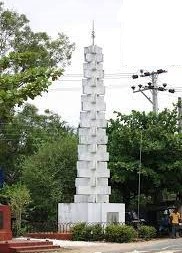Obelisk – Battle of Randeniwela
By Arundathie Abeysinghe
 A monument constructed at the ninth kilometer post on the *Ella – Wellawaya Road near the village of Randeniwela is a unique obelisk to commemorate the Battle of Randeniwela (Battle of Randeniya or Sinhalese – Portuguese War), a battle fought on August 25th 1630. The battle was fought between Portuguese forces commanded by the *Governor Constantinu De Saa de Noronha and King Senarath’s (1604 – 1635) youngest son Prince Maha Astana (pre coronation) who was later crowned as King Rajasinha II (1635 – 1687), the second ruler of Kandyan Kingdom and his brother Prince Vijayapala. The battle was fought near *Wellawaya, situated in close proximity to *Badulla. The battle had taken place when Constantino de Sá launched an invasion via Badulla. The Portuguese army, despite their superior cannon power suffered a massive defeat subsequent to a mass defection by its Lascarin (local militia) contingent. The Portuguese power had been frail during the battle due to the retreat of their troops. During the Battle, the Captain was also killed.
A monument constructed at the ninth kilometer post on the *Ella – Wellawaya Road near the village of Randeniwela is a unique obelisk to commemorate the Battle of Randeniwela (Battle of Randeniya or Sinhalese – Portuguese War), a battle fought on August 25th 1630. The battle was fought between Portuguese forces commanded by the *Governor Constantinu De Saa de Noronha and King Senarath’s (1604 – 1635) youngest son Prince Maha Astana (pre coronation) who was later crowned as King Rajasinha II (1635 – 1687), the second ruler of Kandyan Kingdom and his brother Prince Vijayapala. The battle was fought near *Wellawaya, situated in close proximity to *Badulla. The battle had taken place when Constantino de Sá launched an invasion via Badulla. The Portuguese army, despite their superior cannon power suffered a massive defeat subsequent to a mass defection by its Lascarin (local militia) contingent. The Portuguese power had been frail during the battle due to the retreat of their troops. During the Battle, the Captain was also killed.
According to some historical records, during the battle, unable to bear the ignominy of the defeat, the Portuguese General Don Constantine De Saa had committed suicide. According to historical records, Kandyans had fought ‘with great force and fury’ and the Portuguese had also fought ‘with the utmost valour’.
The Battle of Randeniwela is also recorded in Portuguese sources such as Queyroz’s ‘Conquest’, Ribeiro’s ‘Historic Tragedy’, Menezes’s ‘Rebelion’ as well as an anonymous account known as the ‘Jornada’, considered as a more authentic account of the Battle, written in 1635, approximately five years after the events (of the Battle). In the account of Jornada) there are descriptions about *Muthiyangana Raja Maha Viharya (Temple) too.

According to Jornada’s account of the events leading to the Battle “a stone wall and a ditch on one side and the river (considered as the Badulu Oya) on the other. The next day he spent in sacking and torching the city, particularly the Kataragama Devale (devale meaning Hindu Shrine) and ravaging the countryside, destroying ‘more than 2000 measures of rice in the stalk’ and all the cattle he could find”.
Battle of Randeniwela is considered as a significant historical event that took place during the Portuguese Colonial era in Sri Lanka.
The toponyms of the area surrounding Randeniwela, almost every hamlet have names with military connotations; Hingurukaduwa (the hiding place or store for swords), Hewankandure (a stockade for soldiers), Ulhititenne (a place where palisades were set up), Hinapahuwa (a place where the army retreated), Udawadiya (a camp on the heights), Randeniya (plain of soldiers), Kolabure (a fracas or uproar), Polgaswela (the field where coconuts were dashed to celebrate the victory) and Ballakatuwa (derived from Balakotuwa meaning fort).
- Arhat – According to Buddhism, an Arhat is one who has gained insight into the true nature of existence and achieved *Nirvana.
- Badulla – Situated in lower central hills, Badulla is the capital city of *Uva Province and Badulla District.
- Bodhi Tree – Also known as Bo Tree, according to Buddhist tradition is the specific sacred fig tree (Ficus religiosa) under which the Buddha attained *Enlightenment in Bodh Gaya, India.
- Ceylon – Sri Lanka gained Independence from British Colonials in 1948. In 1972, Ceylon became a republic within the Commonwealth and Ceylon was thereafter known as Sri Lanka.
- Constantine de Saa de Noronha – He was the sixth as well as eighth Governor of *Ceylon during Portuguese rule. He was first appointed under Philip II of Portugal in 1618 and served as the Governor of Ceylon until 1622 and from 1623 until 1730. A strict disciplinarian, incorruptible man of high principles, a blue-blooded fidalgo as well as the Captain General of the Portuguese Colonials, considered as the key player in the Battle admired by his people.
- Ella – Situated at an elevation of 1041 meters above sea level amid lush green forests, rolling carpets of tea and breathtaking mountains, Ella is a small town in the *Badulla District of *Uva Province. Popular among local and foreign tourists, Ella has a mild climate and a laid-back atmosphere.
- Ella – Wellawaya Road – Considered as the most spectacular road in Sri Lanka, this road leads to the southern plains of Sri Lanka. This road is also known as Road A23. According to motorists and tourists. it is the most scenic motorway in Sri Lanka with variation of landscapes, vegetation with great contrasts of climate and scenery, cool and salubrious climate of the central hills to the dry and arid plains of *Wellawaya within a short distance with many spectacular scenes such as the Ella Gap and Ravana Ella (situated by the side of this road).
- Enlightenment – In Buddhism, Enlightenment is when a Buddhist finds the truth about life and stops being reborn as he/she has reached *Nirvana.
- Muthiyangana Raja Maha Viharya – Located in Badulla town, this temple is an ancient Buddhist Temple. Hair relics of the Buddha are enshrined in the dagoba (stupa) of the Temple. There is a thorana (pandol) at the entrance to the temple, a unique design of six levels. Earlier, there had been seven *Bodhi trees in the Temple. But at present there are only four. According to chronicles, the first Bodhi tree is Maliyadeva Bodhi tree, the location where Arhat Maliyadeva – the last *Arhat in Sri Lanka has delivered his sermons when he was in Mahiyangana.
- Nirvana – It refers to a release from the cycle of death and rebirth, the ultimate spiritual goal of Buddhism.
- Uva Province – This is the fourth largest province in Sri Lanka bordered by Central, Eastern and Southern provinces.
- Wellawaya – A town located in Monaragala District, Uva Province of Sri Lanka.







